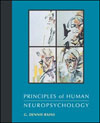G. Dennis Rains,
Kutztown University of Pennsylvania
| apperception | Term used by Wundt and other 19th-century psychologists to indicate higher-order perception.
|
 |
 |
 |
| apperceptive agnosia | Term coined by Lissauer to designate impairment in visual recognition due to a disruption of perception. It may now be defined as impairment in the organization of visual sensations into percepts in the absence of (commensurately severe) impairment in visual sensory processing.
|
 |
 |
 |
| computational neurobiology | An approach that attempts to provide both a rigorous definition of the problems facing the cognitive system in question and a means by which these problems may be solved, without particular reference to explanation of mechanisms on the neuronal or neurological levels.
|
 |
 |
 |
| confabulation | The tendency to deny an impairment and act as if it were not present even when doing so entails behavior that is inconsistent with reality.
|
 |
 |
 |
| cortical blindness | Blindness due to damage to the cortical visual system, particularly the primary visual cortex (V1).
|
 |
 |
 |
| distributed representation | See distributed processing.
|
 |
 |
 |
| dorsal simultanagnosia | Impairment in the ability to perceive the parts of objects, including complex parts, that cannot be easily decomposed into constituent parts or for which such decomposition does not aid perception. Faces are an example of such stimuli. This disorder takes its name from its association with bilateral parietal-occipital lesions.
|
 |
 |
 |
| grandmother cell | A hypothetical type of neuron that has been proposed to be a component in the neural mechanism underlying visual object recognition. According to this view, such cells have highly specific receptive fields (that register the presence of specific objects) because they are the end point in a converging hierarchy of neurons with progressively more specific receptive fields.
|
 |
 |
 |
| imperception | A term (used by Hughlings-Jackson) that Zeki invoked to refer to what is conventionally termed agnosia. Zeki felt that this term emphasizes the essential inseparability of perception and knowing, a central aspect of visual recognition according to Zeki.
|
 |
 |
 |
| local representation | A representation in which there is a one-to-one correspondence between the entity being represented and the activity of a neuron (or group of neurons) encoding the representation. The grandmother cell is an extreme example of a local representation.
|
 |
 |
 |
| optic aphasia | Impairment in the ability to name seen objects, with preserved ability to demonstrate knowledge of their meaning through nonlinguistic means, such as pantomime.
|
 |
 |
 |
| partial cortical blindness | The sparing (or reemergence in the course of recovery) of certain functions after damage to V1.
|
 |
 |
 |
| perceptual categorization (perceptual constancy) | The process by which we recognize an object as equivalent (the same object) despite variations in the characteristics of the proximal stimulus (stimulus on the receptor surface). Also called perceptual categorization.
|
 |
 |
 |
| prosopagnosia | Specific impairment in the recognition of faces.
|
 |
 |
 |
| pure alexia | Impairment in reading without impairment in other linguistic or perceptual skills.
|
 |
 |
 |
| Seelenblindheit | Literally, "soul-blindness." A 19th-century German term for agnosia.
|
 |
 |
 |
| simultanagnosia | Impairment in the ability to perceive and attend to all of the features of an object or a scene at the same time. Individuals with this disorder perceive the individual parts of a complex visual display better than they do the whole. See also ventral simultanagnosia and dorsal simultanagnosia.
|
 |
 |
 |
| subjective contour | The subjective experience of a contour where none is in fact present. The Kanizsa triangle is an example of a figure that elicits the perception of a subjective contour.
|
 |
 |
 |
| ventral simultanagnosia | Impairment in the ability to rapidly code multiple parts of stimuli, particularly stimuli whose perception requires their decomposition into discrete elements. Printed words are an example of such stimuli. Perception thus proceeds part by part. This impairment derives its name from its association with left inferior temporal-occipital lesions.
|
 |
 |
 |
| visual acuity | Clarity or clearness of vision as measured in a number of ways, including detecting the presence or absence of light, detecting the presence of a single target, detecting differences in spatial frequency (e.g., number of lines per degree of visual angle), and detecting differences in brightness.
|
 |
 |
 |
| word forms | The hypothetical percepts that result from the grouping of individual letters into higher-order word units.
|
 |
 |
 |
| word superiority effect | The tendency of normal subjects to recognize a given letter more rapidly and more accurately when it is presented as part of a word than when it is presented as part of a nonword.
|



 2002 McGraw-Hill Higher Education
2002 McGraw-Hill Higher Education

 2002 McGraw-Hill Higher Education
2002 McGraw-Hill Higher Education